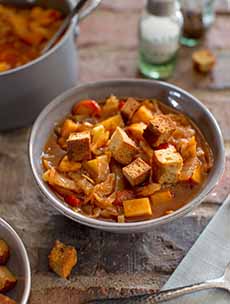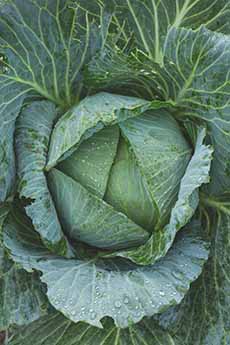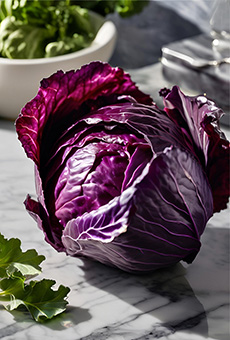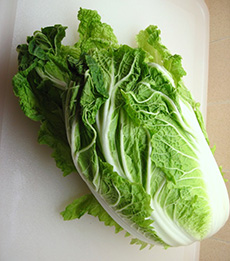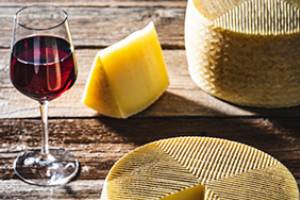A Sweet & Sour Cabbage Soup Recipe For National Cabbage Day
|
February 17th happens to be National Cabbage Day, and this week it also falls on Meatless Monday. And it’s cold out. So it couldn’t be a better day to make this Sweet & Sour Cabbage Soup, a hearty bowlful of cold-weather comfort that’s also: A cozy meal for a winter day, it’s a generous soup pot full of inexpensive ingredients — onions, garlic, potato, carrots, and of course, cabbage, in a paprika-spiced broth. > The history of cabbage and yummy cabbage recipes. > The history of cabbage soup is below. > So are all the cabbage food holidays. > A photo glossary of antioxidant terms. Nava says, “Don’t be intimidated by the length of the ingredient list. Everything just gets tossed into the pot at a leisurely pace.” She adds, “The recommended lemon/sugar balance in the recipe yields a subtle sweet/sour flavor, so feel free to add more to please your palate.” You can substitute sucralose or agave for the sugar. While this recipe was made with green cabbage (the most common), for extra nutrition you can make this soup with red cabbage. See the nutrition details in the footnote†. Ingredients For The Croutons 1. MAKE the croutons. Preheat the oven to 350°F. Spread the bread cubes in a single layer on a baking sheet brush lightly with olive oil. Use a spatula to ensure even browning and crisping by gently stirring them every few minutes. Bake until golden and crisp, about 12 to 15 minutes. Remove from the oven and set aside. 2. HEAT the oil in a large soup pot. Add the onions and garlic and sauté over medium heat until golden, about 8 minutes. 3. ADD the water, carrots, potatoes, cabbage, bell pepper, tomatoes, wine, paprika, and cumin. Bring to a slow boil, then lower the heat. Cover and simmer gently for 30 minutes, or until the vegetables are tender. 4. STIR in the lemon juice and sugar, as well as the optional balsamic vinegar. Add more lemon juice and/or sugar until you get the sweet/sour balance that pleases your palate. Season with salt and pepper. If you’d like a spicier soup, add the cayenne or red pepper flakes to taste. 5. SIMMER over low heat for 5 minutes longer. If time allows, let the soup stand off the heat for an hour or two to develop flavor. If the soup is too crowded, add a bit more water, adjust the seasonings and sweet-sour balance, then heat through before serving. 6. TO SERVE you have two options with the croutons. Either way, sprinkle with snipped dill. Cabbage (Brassica oleracea) is believed to have originated along the European coastal areas of the Mediterranean Sea. The wild ancestors of cabbage, known as wild mustard (Brassica oleracea var. oleracea), grew in these regions and were first domesticated by ancient civilizations, including the Greeks and Romans. Easy to grow even in cold climates, easy to store, simple to make, nourishing, and affordable, cabbage dishes that has been a staple in various cuisines. The health and nutrition angle was underscored in the 1980s as scientific research on oxidative stress and free radicals expanded, and antioxidant-rich foods began to gain traction. > Check out this list of antioxidant foods. Cabbage goes one step further. As a member of the Brassica or Cruciferous family*, “the world’s healthiest vegetables,” During the Middle Ages, as cultivation expanded northward, cabbage soup became a common dish among European peasants. Soups and stews were an essential part of medieval diets, cooked over an open fire with whatever vegetables, grains, or meats were available. Cabbage soup became a signature dish in Eastern European cuisine, in countries like Hungary, Poland, Ukraine, and Russia. Also in the Middle Ages, European cabbage was introduced to Asia, where it became a key ingredient in Chinese, Japanese, and Korean cuisines. Earlier, napa cabbage had been developed in China during the Tang Dynasty (7th–10th centuries C.E.). It’s believed to be a hybrid of bok choy and a turnip-like Brassica. European immigrants brought cabbage to the Americas in the 16th and 17th centuries. It became a common crop in colonial America, widely grown for its hardiness and nutritional value. Cabbage remains a great winter vegetable. Cooler temperatures enhance their sweetness. |
|
|
|
________________ Green Cabbage (Brassica oleracea, photo #4) has the mildest flavor and a firm texture. It’s high in Vitamin K (important for blood clotting and bone health), rich in Vitamin C (boosts immunity and skin health), a good source of fiber (aids digestion), contains sulfur compounds (supports liver detoxification). Red (Purple) Cabbage (Brassica oleracea, photo #5) has a slightly tougher texture and peppery flavor. It’s the highest in antioxidants (rich in anthocyanins—which give it the purple color—and help fight inflammation, plus the polyphenols (the group in which anthocyanins belong0 are linked to heart and brain health), and has about 30% more Vitamin C than green cabbage. Savoy Cabbage (Brassica oleracea var. capitata, photo #6) is milder and more tender than green cabbage. It’s lower in fiber than green cabbage, which makes it easier to digest, but on the other hand, provides less fiber. It has more more folate, which is important for DNA synthesis and pregnancy health; and it contains carotenoids for eye health. Its crinkly leaves make it the most beautiful of the cabbages. Napa Cabbage (Chinese Cabbage) (Brassica rapa subsp. pekinensis, photo #7), another pretty cabbage, has a soft, mildly sweet taste and delicate texture. It’s lower in calories but high in water content for hydration. It’s rich in folate and Vitamin A, which supports skin and eye health. It contains glucosinolates, compounds linked to cancer prevention. Since cabbage is high in water (about 90%) and fiber, it is very filling while being low in calories. The different species range from 25 to 30 calories per 100 grams (3.5 oz) of raw cabbage. ‡It’s easy to make seasoned croutons. You can season them with salt, added to the olive oil or melted butter, but also make: Spiced croutons: Add chili pepper flakes or cayenne to the oil. In other recipes, different spices may pair well, e.g. cumin, curry, garlic, oregano, even sweet spices like allspice, cinnamon, cloves, or nutmeg. Herbed croutons: Add any dried herbs you like—basil, dill, parsley, rosemary, or thyme, e.g. If you prefer fresh herbs, chop them finely and toss the bread cubes in them after they’re finished baking. CHECK OUT WHAT’S HAPPENING ON OUR HOME PAGE, THENIBBLE.COM. |
||

